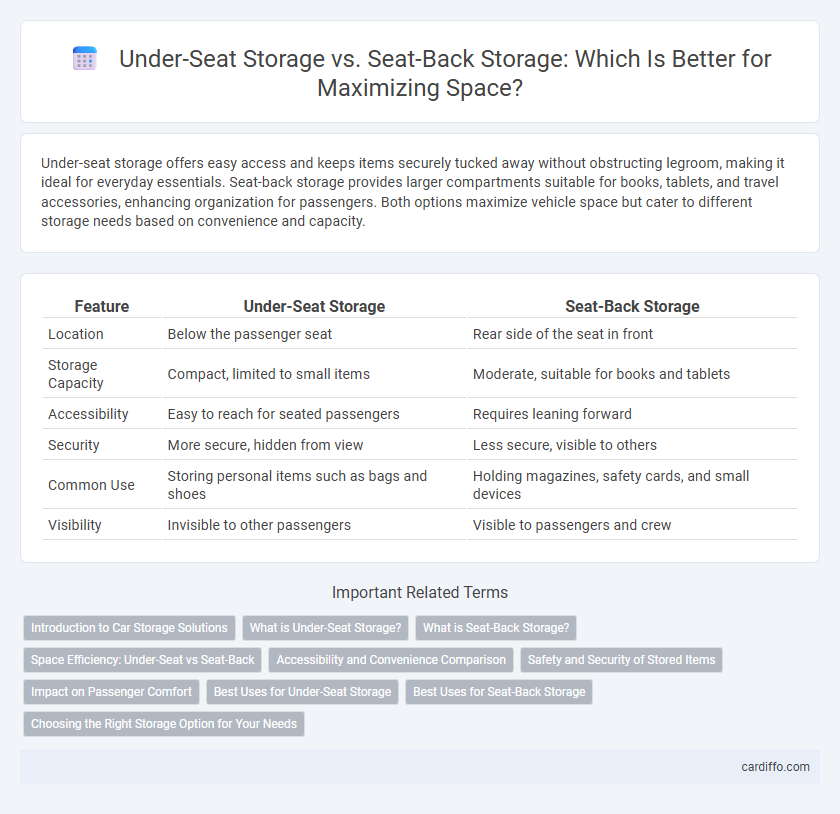Under-seat storage offers easy access and keeps items securely tucked away without obstructing legroom, making it ideal for everyday essentials. Seat-back storage provides larger compartments suitable for books, tablets, and travel accessories, enhancing organization for passengers. Both options maximize vehicle space but cater to different storage needs based on convenience and capacity.
Table of Comparison
| Feature | Under-Seat Storage | Seat-Back Storage |
|---|---|---|
| Location | Below the passenger seat | Rear side of the seat in front |
| Storage Capacity | Compact, limited to small items | Moderate, suitable for books and tablets |
| Accessibility | Easy to reach for seated passengers | Requires leaning forward |
| Security | More secure, hidden from view | Less secure, visible to others |
| Common Use | Storing personal items such as bags and shoes | Holding magazines, safety cards, and small devices |
| Visibility | Invisible to other passengers | Visible to passengers and crew |
Introduction to Car Storage Solutions
Under-seat storage maximizes space by utilizing the area beneath the seats, providing discreet compartments ideal for small items and valuables. Seat-back storage offers convenient access through pockets or organizers attached to the rear of the front seats, perfect for storing documents, tablets, and travel essentials within easy reach. Choosing between under-seat and seat-back storage depends on the need for hidden storage versus immediate accessibility, enhancing overall vehicle organization and passenger comfort.
What is Under-Seat Storage?
Under-seat storage refers to compartments located beneath the seating area, designed to maximize space efficiency by utilizing the often-unused space under seats in vehicles or furniture. This storage option provides easy access and secure containment for small items such as bags, tools, or personal belongings without obstructing legroom. Compared to seat-back storage, under-seat storage offers a lower profile solution that keeps items out of sight, enhancing organization and vehicle interior aesthetics.
What is Seat-Back Storage?
Seat-back storage refers to compartments or pockets located on the rear side of a vehicle's front seats, designed to hold personal items such as books, tablets, snacks, or small bags. This storage option maximizes space efficiency by utilizing otherwise unused areas, providing easy access for rear passengers without cluttering the main cabin. Compared to under-seat storage, seat-back storage offers visibility and convenience but may have size limitations depending on seat design.
Space Efficiency: Under-Seat vs Seat-Back
Under-seat storage maximizes space efficiency by utilizing the often-underutilized area beneath the seat, providing larger and more secure compartments ideal for bulky or heavy items. Seat-back storage offers convenient access and organization for smaller, frequently used items but typically has limited capacity due to slimmer pocket dimensions. Vehicles prioritizing optimized cargo volume and weight distribution commonly favor under-seat storage for enhanced practicality in space management.
Accessibility and Convenience Comparison
Under-seat storage offers easy accessibility by keeping items within quick reach without obstructing the passenger's view or movement. Seat-back storage, while slightly less accessible during travel, provides convenient organization for smaller items such as tablets or magazines. Choosing between the two depends on the priority of immediate access versus organized storage space.
Safety and Security of Stored Items
Under-seat storage offers enhanced safety by keeping items securely tucked away, reducing the risk of objects becoming projectiles during sudden stops or collisions. Seat-back storage compartments can expose stored items to potential theft due to easier visibility and access. Securing valuables under the seat minimizes damage and increases protection during transit, promoting overall vehicle safety.
Impact on Passenger Comfort
Under-seat storage enhances passenger comfort by providing easy access to belongings without encroaching on legroom, reducing cabin clutter and promoting personal space. Seat-back storage often limits knee space and can cause discomfort during longer journeys, especially for taller passengers. Optimal cabin design balances these storage options to maximize both accessibility and passenger comfort.
Best Uses for Under-Seat Storage
Under-seat storage is ideal for stowing items that require easy and quick access, such as bags, shoes, or small tools, without cluttering the cabin or workspace. This type of storage maximizes space in vehicles, offices, or living areas by utilizing the often-overlooked area beneath seats. Its low-profile design prevents obstruction while keeping essential items organized and within arm's reach.
Best Uses for Seat-Back Storage
Seat-back storage is ideal for keeping items like tablets, books, and travel documents easily accessible during trips, providing convenient organization without cluttering the floor area. It is particularly useful in vehicles with limited cabin space, allowing passengers to store personal belongings within arm's reach while maintaining legroom. This type of storage is also beneficial for commuters and families who require a practical solution for frequently used essentials such as snacks, headphones, and charging cables.
Choosing the Right Storage Option for Your Needs
Under-seat storage offers easy access and is ideal for storing smaller items like bags and shoes, maximizing space without cluttering the seat-back. Seat-back storage provides convenient rear-pocket organization, perfect for holding books, tablets, or snacks within arm's reach during travel. Evaluate your specific needs for accessibility and item size to select the most functional and ergonomic storage solution.
under-seat storage vs seat-back storage Infographic

 cardiffo.com
cardiffo.com